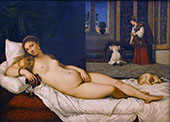Venus of Urbino 1538 By Tiziano Vecellio (TITIAN)
Venus of Urbino by Titian is a fantastic work of art and is one of the most famous nude paintings.
Titian was an Italian Renaissance artist and engraver (also known as Tiziano Vecellio or simply Vecellio) who produced some of the greatest masterpieces in art history.
What did Titian paint in the Venus of Urbino?
The work depicts a young woman before a marriage rite. She’s about to dress before participating in a Venetian ritual called “il toccamano.” This event involved a domestic ceremony involving the woman touching her groom's hand. This action expressed consent to marry a potent and public symbol in a society where reputation was everything.
Titian’s Venus of Urbino painting utilized familiar early renaissance iconography, referencing Greek and Roman figurines of the goddess Venus. In this “Venus Pudica” tradition, the woman covers her pudenda with one hand.
Ironically, the pose isn’t employed to protect her modesty but instead draws attention to the supposedly “hidden” sexuality. The pose also directly references Giorgione’s Dresden Venus (1510-11), for which Titian probably created the background.
Titian’s young Venus reclines on a bed adorned with crumpled white sheets. She gazes at the viewer almost flirtatiously, holding a bunch of red roses. Roses symbolize the goddess Venus herself, as well as love and dedication. The sleeping hound at the bottom of the bed also references fidelity and loyalty, an appropriate motif for a marriage picture.
This particular dog also appears in other Titian paintings, notably a Portrait of Federico II Gonzaga. Federico was the father of Guidobaldo II della Rovere, the individual who purchased (and possibly commissioned) the Venus of Urbino.
How is Venus of Urbano by Titian significant?
Titian’s Venus of Urbino is significant as a renaissance masterpiece in its own right. However, it also offers a fascinating insight into life in sixteenth-century Venice.
The detailed description of a domestic setting is unique in oil paintings of this period. The background offers glimpses into a wealthy home, complete with dutiful servants preparing an opulent blue and gold wedding dress.
Titian’s extraordinary painterly talent is plain to see. With unparalleled deftness in portraying soft yet completely realistic skin, Titian brings the subject to life. Venus of Urbano depicts an intense gaze revealing a genuine sense of personhood and is just one of Titan's famous Renaissance oil paintings.
Purchased by Guidobaldo II della Rovere, the painting formed part of Vittoria della Rovere’s dowry on her marriage to the Grand Duke of Tuscany (Ferdinando II de’ Medici). It is unclear whether the painting is an erotic depiction of a courtesan or a direct celebration of the marriage.
However, we know that it hung opposite the Hellenistic marble sculpture known as the Venus de Medici for many years. This provocative positioning contrasted the beauty of classic Greek idealism with Titian’s modern carnal reality.
Titian’s Venus of Urbino also features prominently in Johan Zoffany’s famed gallery portrait of The Tribuna of the Uffizi, created in the 1770s.
How many paintings did Tiziano Vecellio paint?
Titian enjoyed an amazingly successful and varied career. He painted over 266 artworks during his lifetime, created for a prosperous international clientele.
Titian's oil paintings include landscapes, portraiture, spiritual, mythological, and everyday scenes with a style that changed dramatically from commission to commission.
As well as the Venus of Urbino, Titian’s famous paintings include some great portraits, such as Man with a Quilted Sleeve.
However, Titian’s mythological depictions are rich with color, as seen in Bacchus and Ariadne and his shocking painting, The Rape of Europa 1560.
Renaissance oil paintings by Titan and other famous artists form part of our standard catalog of art replicas.
Buy Titian's the Venus of Urbino art reproduction on canvas and enjoy other famous nude paintings from our Art Collection.
We offer a 100% money back guarantee or replacement service. If for any reason you are dissatisfied with your painting please contact us within 7 days of receipt, advising the reason you are unhappy and we will provide you with all the information you need for its return or replacement.
We ship free to anywhere in the world via FedEx or DHL expedited service with online tracking.
Your painting will be shipped rolled in strong plastic tubing, ready for stretching and/or framing locally. This is the conventional method of transporting hand-painted oil on canvas. Learn more about how your painting is shipped.
We are able to offer a framing service intercontinental U.S. Please contact us if you would like a quotation. Alternatively, should you prefer, we can recommend a framer in your area.
Notes About Your Painting
Please note that replica oil paintings are finished with an additional 10cm (4") of extra canvas on all sides, allowing ample surplus canvas for stretching and framing.
Recently Viewed:
Cannot Find What You Are Looking For?
Reproduction Gallery Information
Customer Service
(Send Us A Message)
Tel: (503) 937 2010
Fax: (503) 937 2011







